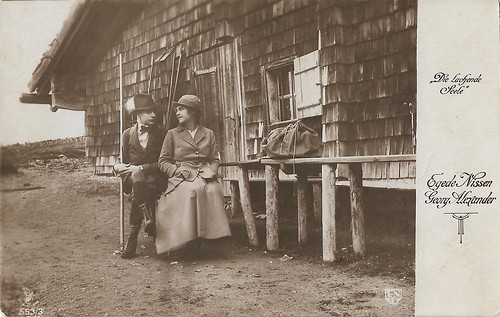
German postcard by Rotophot in the Film Sterne series, no. 553/1. Photo: ENF (Egede-Nissen-Film). Aud Egede Nissen and Georg Alexander (in the middle) in Die lachende Seele/The Laughing Soul (Georg Alexander, 1918).

German postcard by Rotophot in the Film Sterne series, no. 553/2. Photo: ENF (Egede-Nissen-Film). Aud Egede Nissen and Georg Alexander in Die lachende Seele/The Laughing Soul (Georg Alexander, 1918).

German postcard by Rotophot in the Film Sterne series, no. 553/3. Photo: ENF (Egede-Nissen-Film). Aud Egede Nissen and Georg Alexander in Die lachende Seele/The Laughing Soul (Georg Alexander, 1918).
A husband between two women
During the 1910s and 1920s, Aud Egede-Nissen and her sisters Gerd and Ada made a name for themselves in the Nordic and German film industries as actors, producers, and directors. In 1916, Aud met actor and director Georg Alexander. Alexander directed her in Wer wirft den ersten Stein auf Sie? in 1916, and in the same year they married.
Gunnar Iversen writes at Women Film Pioneers Project: "Together with her husband and sisters, Aud Egede-Nissen established a production company in Berlin. Egede-Nissen-Film Company GmbH produced ten features in 1917, the first of which was the comedy Ich heirate meine Puppe (Georg Alexander, 1917) starring Aud in a comic role.
Most of the thirty feature films the company produced were divided into three series, each with one of the three sisters as leading actor and star. The Egede-Nissen series, built around Aud, came in two waves, the first in 1917–1918 and the second in 1918–1919, with a total of eleven features. Some of these were dramatic tragedies, like Die Geburt der Venus (Georg Alexander 1917); others were detective films."
Aud Egede-Nissen was the producer for all thirty features. Sadly, all but two of the films are lost, and the only existing Egede-Nissen-Film Company title with a users’ copy available for screening is Erblich belastet (Georg Alexander, 1919), a film rediscovered in the Desmet Collection of the Eye Filmmuseum in Amsterdam.
Die lachende Seele/The Laughing Soul was scripted by Rudolf Baron and Else Cressin, while Georg Alexander both directed and played the male lead as a husband, Reimar Gellert, who vacillates between two women, his wife and Ingeborg Jensen (Aud Egede Nissen).
While exteriors for Die lachende Seele/The Laughing Soul seem to have been shot in the Alps, interiors were shot at the Fern-Andra-Film studios in Berlin. IMDb and The German Early Cinema Database both date the film as of 1919, but The German Early Cinema Database also mentions the first screening that took place in November 1918 at the Passagetheater in Berlin. So we date the film as of 1918.

German postcard by Rotophot in the Film-Sterne series, no. 553/4. Photo: ENF (Egede-Nissen-Film). Aud Egede Nissen and Georg Alexander in Die lachende Seele/The Laughing Soul (Georg Alexander, 1918).

German postcard by Rotophot in the Film-Sterne series, no. 553/5. Photo: ENF (Egede-Nissen-Film). Aud Egede Nissen and Max Ruhbeck in Die lachende Seele/The Laughing Soul (Georg Alexander, 1918).

German postcard by Rotophot in the Film-Sterne series, no. 553/6. Photo: ENF (Egede-Nissen-Film). Aud Egede Nissen in Die lachende Seele/The Laughing Soul (Georg Alexander, 1919).
Sources: Gunnar Iversen (Women Film Pioneers Project), The German Early Cinema Database, and IMDb.
No comments:
Post a Comment